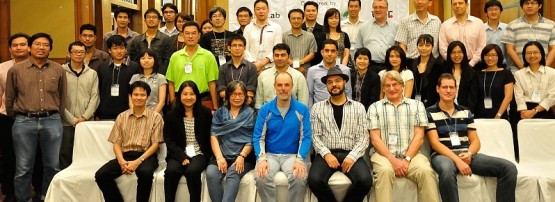
I attended AINTEC 2014 at Chiang Mai last week, and I was overwhelmingly impressed by the strong group of ICT specialists who are helping Internet technology deploy, and conducting world class research and development.
The meeting is an ACM SIGCOMM event, and I saw presentations of a very high standard from local and international participants. I presented on an APNIC Labs measurement system, some issues we’re confronting in the collection of internet-wide data, and how we’re compensating for them.
Because I’m a Raspberry Pi user, I was very drawn to the presentation Kotaro Kataoka gave on a pi based WiFi measurement system. They’ve deployed a network of wifi-enabled units around their residential and teaching buildings at the Indian Institute of Technology, Hyderabad and update a central datastore periodically with signal strength, error rate, and other data to map out the reception. A really nice mash up of low cost hardware, open-source software and data modelling for network performance.
Dario Rossi from ParisTech, who is also a PC co-chair presented on their geolocation modelling, which uses a nice heuristic method of determining location of addresses by a weighted geo-centroid method, combined with other data such as population size to set limits to the circle-of-error distance around an imputed location. The team have compared RIPE Atlas and planetlabs data, and competing methodologies and show a very good success rate for a simple, easy to understand method. It’s going to be published in Infocomm in 2015 and is well worth waiting to see, or read.
Panita Pongpaibool from the National Electronics and Computer Technology Center, Thailand presented on NetHam-nano, which is a publish-subscribe model of network monitoring, using the ‘eventual consistency’ model of data exchange over AMQP. I particularly like publish-subscribe because in a former life I was the technical manager at a CRC, which researched this data sharing technique ‘before it was famous’ and I think its a very good fit for the problem. Panita and her team have taken Nagios (the systems monitoring package) and extended it to use their federated data model. I think this is a really interesting approach and I think it would be worth deploying.
Several of us wound up at Chiang Mai international airport before our flights, and had a very impromptu research colloquium around a powerpoint as we recharged our laptops.
Kanchana runs a very well organized, focused network research activity and has developed a wealth of capability in Thailand. I ate dinner with several of her graduates (including Panita) who are now active in Thai tertiary education, research and Government.
Thanks to Kanchana Kanchanasut for extending the invitation. You can feel proud of having trained and nurtured a vibrant community of specialists. Sukumal Kitisin and Sweet Mae Monteclaro, thank you for facilitating my visit.
The views expressed by the authors of this blog are their own and do not necessarily reflect the views of APNIC. Please note a Code of Conduct applies to this blog.
